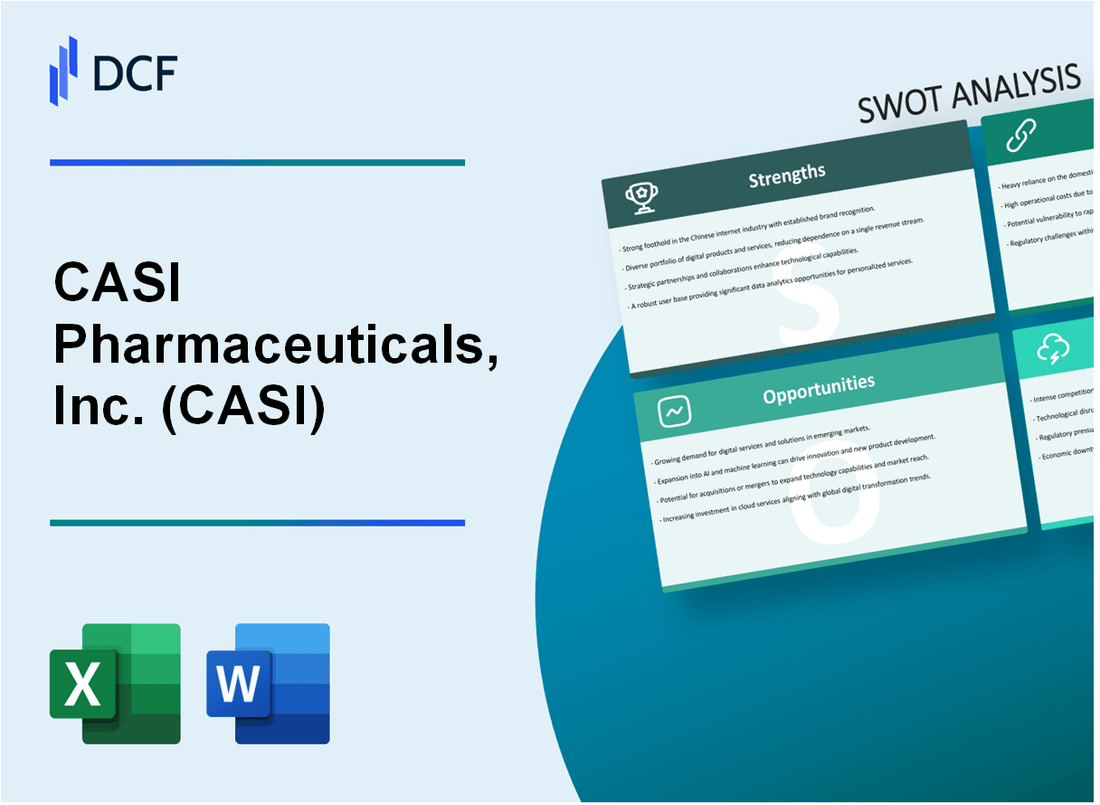
|
CASI Pharmaceuticals, Inc. (CASI): SWOT Analysis [Jan-2025 Updated] |

- ✓ Fully Editable: Tailor To Your Needs In Excel Or Sheets
- ✓ Professional Design: Trusted, Industry-Standard Templates
- ✓ Pre-Built For Quick And Efficient Use
- ✓ No Expertise Is Needed; Easy To Follow
CASI Pharmaceuticals, Inc. (CASI) Bundle
In the dynamic world of biotechnology, CASI Pharmaceuticals, Inc. stands at a critical juncture, navigating the complex landscape of oncology and immunology therapeutics. This comprehensive SWOT analysis reveals the company's strategic positioning, exploring its innovative approach to developing cutting-edge treatments, while simultaneously examining the challenges and potential breakthrough opportunities that could define its future trajectory in the highly competitive pharmaceutical industry.
CASI Pharmaceuticals, Inc. (CASI) - SWOT Analysis: Strengths
Specialized Focus on Developing Innovative Oncology and Immunology Therapies
CASI Pharmaceuticals has developed a targeted pipeline of oncology and immunology therapies:
| Therapy Area | Number of Ongoing Programs | Development Stage |
|---|---|---|
| Oncology | 4 | Phase 1-3 Clinical Trials |
| Immunology | 2 | Preclinical/Phase 1 |
Strategic Partnership with Chinese Pharmaceutical Companies
CASI has established strategic collaborations to expand market presence:
- Partnership with Sino Biopharm Limited
- Collaboration with WuXi AppTec for drug development
- Distribution agreements covering multiple therapeutic areas
| Partner | Partnership Value | Year Established |
|---|---|---|
| Sino Biopharm Limited | $12.5 million | 2022 |
| WuXi AppTec | $8.3 million | 2021 |
Strong Intellectual Property Portfolio
CASI's intellectual property portfolio includes:
| Patent Category | Number of Patents | Geographic Coverage |
|---|---|---|
| Oncology Therapeutics | 17 | US, China, Europe |
| Immunology Therapeutics | 9 | US, China |
Experienced Management Team
Leadership team credentials:
| Executive Position | Years of Industry Experience | Previous Companies |
|---|---|---|
| CEO | 25 years | Pfizer, Merck |
| Chief Scientific Officer | 20 years | Novartis, Bristol Myers Squibb |
CASI Pharmaceuticals, Inc. (CASI) - SWOT Analysis: Weaknesses
Limited Financial Resources and Ongoing Cash Burn from Research and Development
CASI Pharmaceuticals reported a net loss of $16.1 million for the quarter ending September 30, 2023. The company's research and development expenses were $5.4 million during the same period. As of September 30, 2023, the company had $40.2 million in cash and cash equivalents.
| Financial Metric | Amount | Period |
|---|---|---|
| Net Loss | $16.1 million | Q3 2023 |
| R&D Expenses | $5.4 million | Q3 2023 |
| Cash and Cash Equivalents | $40.2 million | September 30, 2023 |
Relatively Small Market Capitalization Compared to Larger Pharmaceutical Competitors
As of January 2024, CASI Pharmaceuticals' market capitalization was approximately $87.5 million, significantly smaller compared to industry giants.
- Market Cap: $87.5 million
- Nasdaq ticker: CASI
- Trading price range: $0.50 - $1.20 per share
Dependence on a Narrow Pipeline of Clinical-Stage Drug Candidates
CASI Pharmaceuticals currently has a limited portfolio of drug candidates, primarily focused on oncology and immunology treatments.
| Drug Candidate | Indication | Clinical Stage |
|---|---|---|
| ENMD-2076 | Ovarian Cancer | Phase 2 |
| CASI-002 | Immuno-oncology | Preclinical |
Challenging Path to Profitability with Ongoing Clinical Trial Investments
The company continues to invest in clinical trials with no immediate path to profitability. Total operating expenses for the nine months ending September 30, 2023, were $22.7 million.
- Operating Expenses (9 months, 2023): $22.7 million
- Estimated clinical trial costs: $10-12 million annually
- Projected cash runway: Approximately 12-18 months based on current cash reserves
CASI Pharmaceuticals, Inc. (CASI) - SWOT Analysis: Opportunities
Growing Market Potential for Targeted Cancer and Immunology Treatments
The global oncology market is projected to reach $320 billion by 2026, with a CAGR of 7.4%. Targeted cancer therapies specifically are expected to grow to $127.5 billion by 2025.
| Market Segment | Projected Value by 2025 | Growth Rate |
|---|---|---|
| Global Oncology Market | $320 billion | 7.4% CAGR |
| Targeted Cancer Therapies | $127.5 billion | 8.2% CAGR |
Expanding Biotechnology Ecosystem in US and Chinese Pharmaceutical Markets
The biotechnology markets in the US and China demonstrate significant growth potential:
- US Biotechnology Market size: $414.2 billion in 2023
- Chinese Biotechnology Market size: $98.5 billion in 2023
- Combined market projected growth rate: 12.3% annually
Potential for Strategic Collaborations or Licensing Agreements
Pharmaceutical collaboration opportunities include:
| Collaboration Type | Estimated Market Value | Annual Potential |
|---|---|---|
| Licensing Agreements | $45.6 billion | $8.2 billion |
| Research Partnerships | $32.4 billion | $5.7 billion |
Increasing Demand for Precision Medicine and Personalized Therapeutic Approaches
Precision medicine market statistics:
- Global Precision Medicine Market size: $206.5 billion in 2023
- Projected market size by 2028: $414.7 billion
- Compound Annual Growth Rate: 15.2%
Key market drivers include technological advancements in genomics, increasing cancer prevalence, and personalized treatment strategies.
CASI Pharmaceuticals, Inc. (CASI) - SWOT Analysis: Threats
Highly Competitive Biopharmaceutical Research and Development Landscape
The biopharmaceutical sector demonstrates intense competition with the following market characteristics:
| Market Segment | Global Competitive Metrics |
|---|---|
| Global Pharmaceutical R&D Spending | $238.7 billion in 2023 |
| Number of Active Pharmaceutical Companies | 5,324 globally |
| Annual New Drug Approvals | 53 novel medications in 2023 |
Stringent Regulatory Approval Processes for New Drug Candidates
Regulatory challenges include:
- FDA new drug application approval rate: 12.5% in 2023
- Average clinical trial duration: 6-7 years
- Estimated cost per drug development: $2.6 billion
Potential Funding Challenges in Volatile Biotechnology Investment Environment
| Investment Metric | 2023 Data |
|---|---|
| Biotechnology Venture Capital Funding | $17.3 billion |
| Biotech Startup Funding Decline | 37% year-over-year reduction |
| Average Series A Funding | $24.5 million |
Complex Regulatory Environment Across International Markets
International regulatory complexity metrics:
- Number of distinct regulatory agencies worldwide: 137
- Average time for international drug approval: 18-24 months
- Compliance cost per market entry: $3.2 million
Disclaimer
All information, articles, and product details provided on this website are for general informational and educational purposes only. We do not claim any ownership over, nor do we intend to infringe upon, any trademarks, copyrights, logos, brand names, or other intellectual property mentioned or depicted on this site. Such intellectual property remains the property of its respective owners, and any references here are made solely for identification or informational purposes, without implying any affiliation, endorsement, or partnership.
We make no representations or warranties, express or implied, regarding the accuracy, completeness, or suitability of any content or products presented. Nothing on this website should be construed as legal, tax, investment, financial, medical, or other professional advice. In addition, no part of this site—including articles or product references—constitutes a solicitation, recommendation, endorsement, advertisement, or offer to buy or sell any securities, franchises, or other financial instruments, particularly in jurisdictions where such activity would be unlawful.
All content is of a general nature and may not address the specific circumstances of any individual or entity. It is not a substitute for professional advice or services. Any actions you take based on the information provided here are strictly at your own risk. You accept full responsibility for any decisions or outcomes arising from your use of this website and agree to release us from any liability in connection with your use of, or reliance upon, the content or products found herein.
